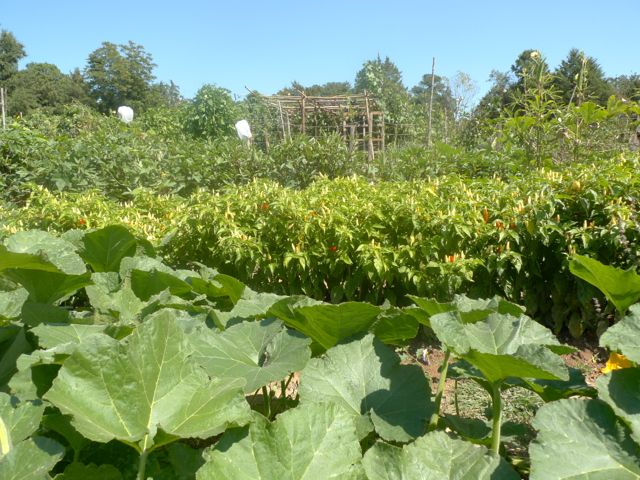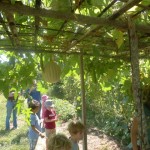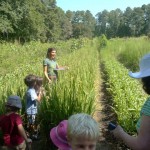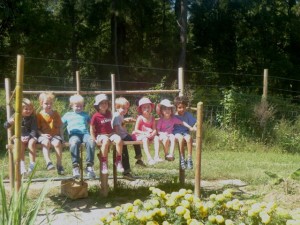Transplanting Traditions Community Farm.
By Cecil Poole
Every time I visit my Daughter in Law takes me to another farm. This time it was to the Transplanting Traditions Community Farm, just ten minutes or so drive from her home. We went there for a little party for Vaughan, a friend of my five year old grand-daughter. Vaughan’s mother had been involved in raising funds for the farm and the party was a form of thanks for that. We arrived on a warm afternoon in the middle of September, early fall, and were met at the gate with what, to my eyes, looked like a verdant market garden, yet totally unlike any market garden I’d seen in Australia.
 This was no mono-culture, no acres and acres of cabbage, or broccoli, potatoes or beans, but a mixed garden, more permaculture like, more like an urban community garden – yet even more verdant, almost fecund. Then I twigged it, I remembered where I’d seen something similar – in Java, and in Vietnam, yes this was South East Asian in appearance.
This was no mono-culture, no acres and acres of cabbage, or broccoli, potatoes or beans, but a mixed garden, more permaculture like, more like an urban community garden – yet even more verdant, almost fecund. Then I twigged it, I remembered where I’d seen something similar – in Java, and in Vietnam, yes this was South East Asian in appearance.
Nicole, our guide, and one of the farm co-ordinators, set the children with bracelets of sticky-side-out masking tape to hold the seeds, flowers and grains of soils that drew their attention. (Obviously Nicole had been a teacher – clever me for seeing that!)  Going through the farm we saw, felt and tasted lemon grass, kafir lime leaves, mints and basils of many varieties, brassicas, radishes, greens of all descriptions, and so many types of beans. We saw pumpkin growing above our head, supported on structures made of split bamboo, and in the shade beneath there was ginger and other shade loving tropical plants. And everywhere I looked I could see chili peppers, yellow, red, green, striped, large, small, tiny, most hanging down, some standing upright on their stems. Oh yes, the Asian influence – more so than Central America.
Going through the farm we saw, felt and tasted lemon grass, kafir lime leaves, mints and basils of many varieties, brassicas, radishes, greens of all descriptions, and so many types of beans. We saw pumpkin growing above our head, supported on structures made of split bamboo, and in the shade beneath there was ginger and other shade loving tropical plants. And everywhere I looked I could see chili peppers, yellow, red, green, striped, large, small, tiny, most hanging down, some standing upright on their stems. Oh yes, the Asian influence – more so than Central America.
 This farm of just a few acres, had row after row of highly productive plants. Even a few rows of dryland rice. Every few rows there was another shade structure with pumpkin or squash covering it, there would be a largish bamboo seat or platform nearby. And the farm was used by refugees from Burma, Karen peoples from the Thai border region, mountain people with a strong culture of self sufficiency through farming.
This farm of just a few acres, had row after row of highly productive plants. Even a few rows of dryland rice. Every few rows there was another shade structure with pumpkin or squash covering it, there would be a largish bamboo seat or platform nearby. And the farm was used by refugees from Burma, Karen peoples from the Thai border region, mountain people with a strong culture of self sufficiency through farming.
 “We come here together, we sit together, sharing our feelings sharing our job availabilities, sharing our future goals and objectives together. This is the most beautiful thing and one of my favourite parts of why I love to come to the garden” says Pot Hsu, one of the farmers. Another, Choo Htoo says “By growing here I can save money. I can get fresh and healthy vegetables all the time. By growing I never have problem with my family about vegetables. Besides I can share some vegetables with my neighbourhood.”
“We come here together, we sit together, sharing our feelings sharing our job availabilities, sharing our future goals and objectives together. This is the most beautiful thing and one of my favourite parts of why I love to come to the garden” says Pot Hsu, one of the farmers. Another, Choo Htoo says “By growing here I can save money. I can get fresh and healthy vegetables all the time. By growing I never have problem with my family about vegetables. Besides I can share some vegetables with my neighbourhood.”
The farm mission is “increasing agricultural entrepreneurship and cross-cultural understanding through farming and food”.
I came away thinking what a respectful way to treat with refugees, and maybe, just maybe, we can learn something from them.

Pingback: Persian Food | pcbycp